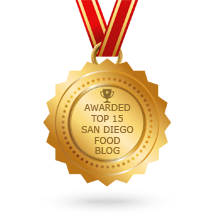Robin Asbell: The Enlightened Hedonist
One of the best food writing jobs I've had is writing for Rancho La Puerta's blog and app. Every month, I go down to their cooking school, La Cocina Que Canta, and participate in a hands-on class taught by a renowned cooking teaching, restaurateur, or cookbook author.
They've given me permission to put these posts on San Diego Foodstuff, so in the coming months you'll periodically see them, starting with this piece on the wonderful Robin Asbell.
As Robin Asbell walked back to La Cocina Que Canta from the nearby fields where several of us had just squealed with delight picking leeks and basil, she chuckled at the notion of a well-known chef writing a piece admitting she didn’t like gardening because there were INSECTS!
“Who would say that?” she asked. “That’s just part of growing your own food. Silly.”
Asbell, who lives in Minneapolis, has her own small garden where she grows tomatoes, garlic, and herbs—including eight types of basil. It’s not really a surprise since Asbell is a self-described “occasional pescatarian”—a vegetarian who sometimes indulges in fish. Her interest in vegetarianism began when she was 16 and friends of her parents—both teachers—intrigued her with their vegetarian approach to food. Asbell had to prove her commitment, though. When she declared her intentions, her mom made her read Diet for a Small Planet and write a report on it.
Clearly, Mom had an impact as did the book. The incident launched Asbell into a career that began with her baking loaves of whole wheat bread in high school that she sold to a local co-op. Asbell studied art in college in Illinois and briefly attended graduate school before realizing she didn’t want a career as an academic and leaving to be a chef.
“I got my first full-time chef job at a jazz bar/vegetarian restaurant,” she recalled. “I was at school in Champagne, Ill., and I found the ad in a restroom. I convinced the owners to hire me and that was it.
Since then, Asbell has gone on to work as a private chef, teach, and write two books, The New Vegetarian Cookbook and The New Whole Grains Cookbook
. Currently, she’s at work on The Big Book of Vegan, a collection of 400 recipes to be published by Chronicle Books in Fall 2011.
But on this sparkling September afternoon, here we are with her in la cocina looking over the various ingredients—including some grown on the farm just yards away. We’re making a smoky herb salad with tomato vinaigrette, a light Tuscan bean and salmon salad with bruschetta, goat cheese gnocchi with lemony broccoli rabe sauce, and so much more. The kitchen island is overflowing with greens and nuts and cheeses and surrounded by women not quite sure where to start. But Asbell gets the group launched and makes her way around to lend a hand, give tips, offer advice, and crack a joke or two.
We learned that when making gnocchi, it’s best to use as little flour as possible, not to handle the dough too much, and do a quick test with just one gnocchi—dropping it in boiling water to see if it holds together or if the dough needs just a tad more flour.
I got a great julienning tip. Using a carrot, Asbell showed me a way to cut on the diagonal and leave the pieces spread out like a deck of cards, then slice them thinly. Very cool. I worked through the carrots and then summer squash with relative ease.
We also learned to be sure to double check the oven temperature so that an apple streusel cake that is supposed to bake for 40 minutes at 350 doesn’t end up in the oven at over 400 degrees before being hustled out after 10 minutes. Let’s just say things happen and we learned from Asbell to roll with it and laugh. And, actually, the cake still turned out well.
With seven dishes made and sitting on the side table buffet style, Asbell gave us a little insight into her philosophy of food and eating before we dug in. “I’m an enlightened hedonist,” she said. “I want to have fun but I don’t want to suffer.”
A beautiful presentation will elevate your meal to fine dining, and a marinated grain salad is as fine as anything out there. This is just a beginning from which to get creative. Whatever is fresh and in season simply needs an artful approach to look nice in a composed salad. Blanched asparagus, snow peas, avocado, or jicama sticks can liven up the plate.
1/2 cup hazelnuts
1/2 cup chopped fresh parsley
3 cloves garlic
1/2 teaspoon salt
6 tablespoons balsamic vinegar
1 teaspoon dried tarragon
3/4 cup extra virgin olive oil
1 large roma tomato
4 cups salad spinach, washed and dried
1 large red bell pepper, roasted and slivered
1 large carrot, julienned
1 3.5 ounce package enoki mushrooms, or 1 bunch asparagus, blanched
2. Cut the tomato in half vertically and scrape out the seeds, then slice in vertical spears. Use a channel knife or paring knife to slice shallow, lengthwise grooves in the yellow squash, and then slice thinly.
3. To compose the salad on a large platter, spread the spinach on the platter to the edges, then mound the cooled grain in the center, leaving some spinach exposed. Arrange the carrot julienne in four fanned groupings on the grain, evenly spaced around the edges. Arrange the squash between the groups of carrots. Place the pepper slivers across the top of the mound of grain, and then arrange the asparagus or enokis and tomato spears atop that. To compose on individual plates, place the grain to one side, and group the vegetables around the plate.






























